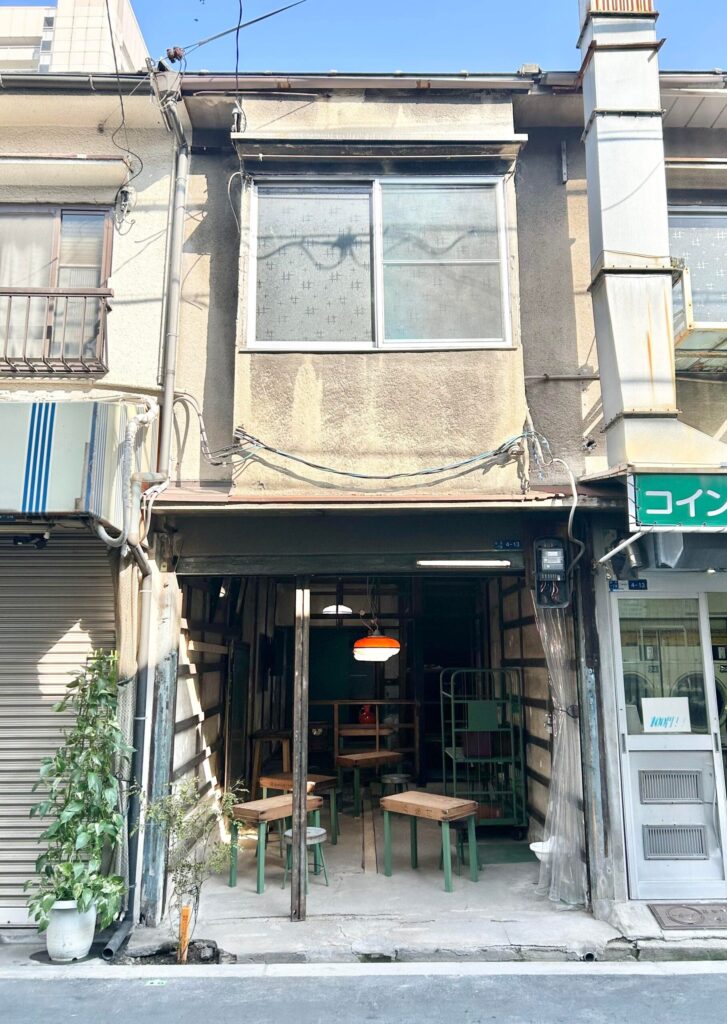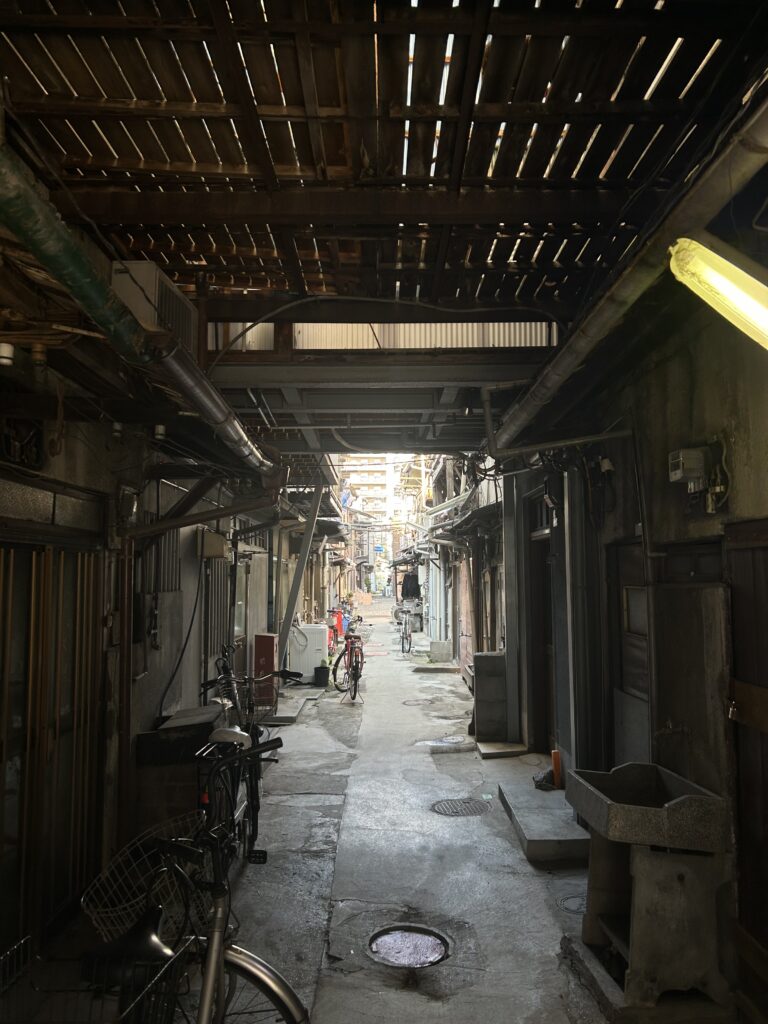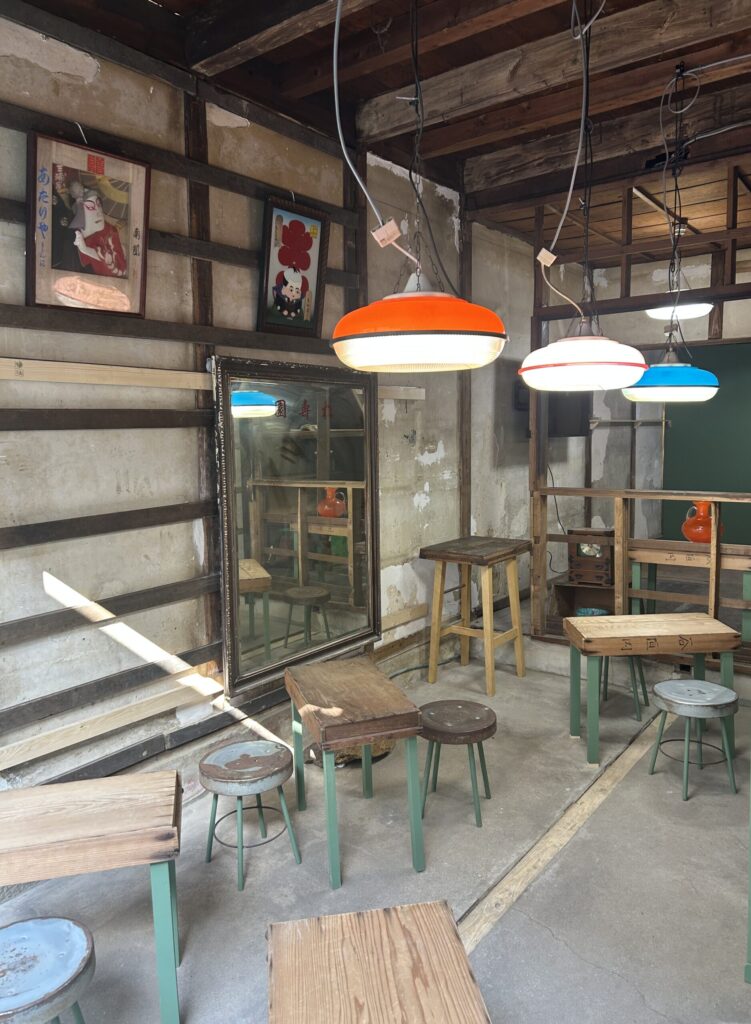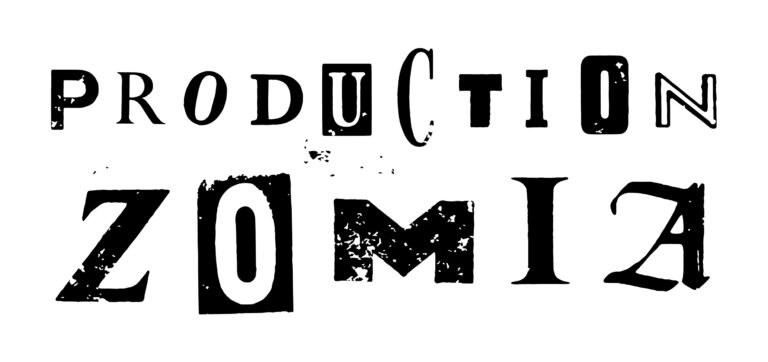まえとうしろ、まんなかとすみっこ

ここは再開発の波に吹き飛ばされそうになりながら失われつつあるものを見つめる—そんな場所です
ほんとうに過去は後ろに置いていかれ前には未来しかないのでしょうか
55年前の万博は大勢の人たちが未来を見るために行ったそうです
さて 今度の万博ではなにが見られるのでしょうか
この街には逃れる人もいれば抱きしめる人もいます
建物も人も変わり続けても大切なものがしっかりと残っています
街のまんなかなのにすみっこにあるかのようなこの場所はお茶を飲みながら誰かと会話をするのにふさわしいところです
急な階段を登った2階では客人たちがたまにここで時間を過ごしています

Cafe Atariya: Front and Back, Center and Peripheral
This place stands on the brink of a large redevelopment wave, yet it continues to remain at what is being lost. But does the past truly remain at the back and we see in the front only the future? Fifty five years ago, crowds flocked to the Expo to experience a glimpse of the future. Now, what will be seen at the current Expo?
In this city, there are those who seek to escape and those who cuddle them. Even as buildings and people continue to change, the things that truly matter remain firmly in place.
Though located in the heart of the city, this place feels like a hidden corner—perfect for sharing tea and conversation. Upstairs, beyond the steep staircase, our guests sometimes spend time reflecting and exchanging thoughts.
Over the next six months, what kind of dialogues and reflections will resonate within the Harmonica Row Houses? A harmony cannot be truly beautiful with only pristine sounds. The sounds created by guests and local residents will likely resonate differently from those of Yumeshima. They will speak of the Earth and its creatures, of hope and peace, of the ethnicity and culture, of daily life in Sannō. And of what comes after all of this is over.

【開催概要】
Study:大阪関西国際芸術祭 2025
会 場 : 山王ハモニカ長屋
住 所 : 大阪府大阪市西成区山王1丁目4-13 (Google map)
アクセス:大阪メトロ御堂筋線/堺筋線「動物園前」駅
4番出口より徒歩約8分
会 期 : 2025年4月13日(日) 〜 10月13日(月)
開館時間 : 13:00 〜 19:00(最終入場は閉館30分前)
休館日 : 月曜日(祝日の場合は翌火曜)
※7月21日(月)・7月22日(火)はオープン
チケット:入場には展覧会パスポートまたは開幕パスが必要です。
チケット情報はこちら>>>
[Exhibition Outline]
Study: Osaka Kansai International Art Festival 2025
VENUE : Sannō Harmonica Row Houses (MAP)
DATE : Apr 13 (Sun) – Oct 13 (Mon), 2025
OPENIG HOURS : 13:00 – 19:00 (entry up to 18:30)
Closed on Wednesdays (If it is a national holiday,
the following Tuesday is closed.) except July 21 (Mon) and 22 (Tue)
TICKET : Exhibition passport or opening pass is required.
Ticket Information >>>
ACCESS : About 8 min by walk from Dobutsuen-mae Station Exit 4 ( Osaka Metro Midosuji Line / Sakaisuji Line)
このプロジェクトについて
私たちが招く客人は、この土地で活動する隣人たちとの話し合いをもとに、これまでの活動によって緩やかにつながってきたアジアのアーティスト/キュレーターによって推薦されています。
これまでの社会と芸術は自律的で独立した個であることを私たちに要請してきました。この協働的実践は、責任とケア、私的領域と公的領域を分割しがちな思考に対する実験でもあります。共有/共同/協力を基礎にした生き方が、この街と長屋を舞台に奏でられます。
「万博は人類の進歩を確認し合う場だった」「遠くから持ってきたものを、ひとつの場所に展示するというアイデアが生まれた」(人類の進歩を把握する試み、国際博覧会――展示から対話へ)。
これは言うまでもなく博物館の成り立ちとも深く関わる考え方です。それをそう簡単に肯定することができないのは、進歩は差別と、展示は搾取と結びついた可能性があるからです。
プロダクション・ゾミアはアジアのアーティスト/キュレーターが協働する活動として2021年から各地で展覧会やアートプロジェクトをおこなっています。なんらかのメッセージや表現を提示(represent)するのではなく、互いの考えや活動を学びあう過程(process)を重視した活動のため、そのたびに繰り返し参加するメンバーと新しく加わるメンバーで構成されています。
これはプロダクション・ゾミアと西成で活動する複数の団体との協働から生まれたプロジェクトです。西成は「人類館」を1903年に展示した博覧会会場とも近く、また1970年大阪万博前後に増加した日雇い労働者の街で、現在は政策やインバウンド需要で急激に街が変化しつつあります。そこで私たちは活動期間が限られたプロジェクトで何ができるのかを、この土地で長く活動する団体と話し合うことから企画をはじめました。釜ヶ崎芸術大学ココルーム、Kioku手芸館たんす、SUCHSIZEとの話し合いから、これまで協力や支援の対象だった高齢者の人たちが減少し、逆に増加しているアジアの移民労働者たちが増えている変化に目を向けることにしました。アーティストが必ずしも西成のコミュニティに関わる調査や作品制作をおこなうわけではなくても、それぞれの言語を使ってコミュニケーションして生活することでこれまでと異なる接点が生まれるかもしれないと考えました。
この半年間のあいだにハモニカ長屋に生まれる対話や思索はどんな音を奏でるでしょうか。どんな音がそこに重なり合うかは分かりません。それを客人たちが自分たちでは聴くことはないかもしれません。私たちが招く客人は、この土地で活動する隣人たちとの話し合いをもとに、これまでの活動によって緩やかにつながってきたアジアのアーティスト/キュレーターによって推薦されています。これまでの社会と芸術は自律的で独立した個であることを私たちに要請してきました。この協働的実践は、責任とケア、私的領域と公的領域を分割しがちな思考に対する実験でもあります。共有/共同/協力を基礎にした生き方が、この街と長屋を舞台に奏でられます。
About This Project
“The Expo was a place for humanity to reaffirm its progress.” ”The idea of bringing things from afar and displaying them in one place.”
This idea is, needless to say, deeply connected to the formation of museums. The reason it cannot be easily affirmed is that progress may be tied to discrimination, and exhibition to exploitation. It distinguishes between those who are advancing and those who are stagnant, detaching objects from their original places and rendering them interchangeable. Will this model still persist after two centuries?
Production Zomia has been organizing exhibitions and art projects in various locations since 2022, focusing on collaborative activities between Asian artists and curators. Instead of representing a specific message or expression, the activities emphasize the process of learning from each other’s thoughts and work. Therefore, the group consists of both recurring participants and new members joining each time.
This project was born from collaboration between Production Zomia and several organizations active in Nishinari. Nishinari is near the exposition site where the “Human Pavilion” was displayed in 1903 and was also the area where day laborers increased after the 1970 Osaka Expo. Currently, the area is rapidly changing due to policies and foreign tourists. Therefore, we started the project by discussing with local organizations that have long been active in the area what could be done in a project within six months.
Through discussions with organizations such as Kamagasaki Art University Cocoroom, Kioku Crafthouse Tansu, and SUCHSIZE, the idea emerged to create a connection with the increasing number of Asian migrant workers, as the elderly people who were once the focus of support have been decreasing. While artists do not necessarily have to engage directly with the Nishinari community through research or creating works, the goal is to create new connections by communicating using different languages.
Over the next six months, the dialogues and reflections emerging within the Harmonica Row Houses will create a variety of sounds. What sounds will overlap and resonate remains unknown. Perhaps the guests themselves may never hear them.
The guests we invite are recommended by Asian artists and curators, based on discussions with neighbors who live and work in this area. This collaborative practice is also an experiment in responsibility and care, challenging the mindset that often divides the private and the public.
Society and art have long demanded that we exist as autonomous, independent individuals. In contrast, here in this city and these row houses, a way of life based on sharing, collaboration, and cooperation will take shape and unfold.
